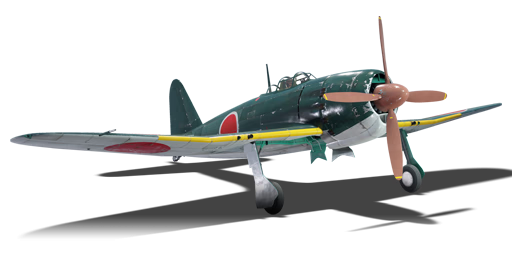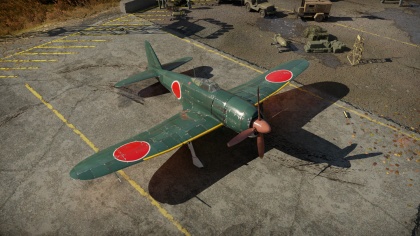A7M2
Contents
| This page is about the Japanese fighter A7M2. For premium version, see A7M1 (NK9H). |
Description
The A7M2 Reppu is a Rank IV Japanese fighter
with a battle rating of 5.0 (AB), 5.3 (RB), and 4.7 (SB). This aircraft was introduced in Update 1.55 "Royal Armour".
General info
Flight Performance
The A7M Reppu was designed to be an improved version of the famed A6M Zero fighter, and as such, retains some of its legendary older brother's characteristics. The Reppu is an overall smooth operator at most altitudes thanks to its decent acceleration, vastly improved speed and decent manoeuvrability. Less manoeverable than the Zero, it can at certain times really struggle in dogfights, the rudder has a want to fight you at every turn requiring forceful control and slight damage to the airframe negates most of its ability to dogfight anything but the slowest turners effectively. The most noteworthy change is the replacement of the underpowered Nakajima Sakae Radial engine with a significantly more powerful Mitsubishi Ha-43 Radial. This new engine propels the Reppu to higher speeds previously unobtainable by the Zero and turns this aircraft from a nuisance to a universally feared opponent.
| Characteristics | |||||||
|---|---|---|---|---|---|---|---|
| Stock | |||||||
| Max Speed (km/h at 5,660 m) |
Max altitude (meters) |
Turn time (seconds) |
Rate of climb (meters/second) |
Take-off run (meters) | |||
| AB | RB | AB | RB | AB | RB | ||
| 608 | 589 | 11000 | 19.3 | 20.2 | 15.1 | 15.1 | 250 |
| Upgraded | |||||||
| Max Speed (km/h at 5,660 m) |
Max altitude (meters) | Turn time (seconds) | Rate of climb (meters/second) |
Take-off run (meters) | |||
| AB | RB | AB | RB | AB | RB | ||
| 655 | 629 | 11000 | 18.8 | 19 | 22.8 | 18.5 | 250 |
Details
| Limits | ||||
|---|---|---|---|---|
| Wing-break speed (km/h) |
Gear limit (km/h) |
Combat flap (km/h) |
Max Static G | |
| + | - | |||
| 826 | 310 | ~?? | ~? | |
Survivability and armour
- 70 mm bulletproof glass in front of the pilot
- 13 mm steel plate behind the pilot seat
- Self-sealing fuel tanks
While being slightly more durable than its older brother, the Reppu is still very vulnerable to any kind of battle damage. Anything with greater than .50 calibre weapons will be able to take off a wing or worse. The wingspan has also increased significantly to keep the manoeuvrability of the Zero while supporting increased weight added from the guns, engine and other updates. A downside is that this makes the wings easier to hit. However, The manoeuvrability of the Reppu allows this aircraft to avoid most damage if you can keep turning.
Armaments
Offensive armament
The A7M2
- 2 × 20 mm Type 99 Model 2 cannon, wing-mounted (200 RPG = 400 total)
- 2 × 13.2 mm Type 3 machine gun, wing-mounted (300 RPG = 600 total)
Usage in battles
The A7M is played almost exactly like the Zero, but with a few changes due to the good performance. Due to its high top speed (for an IJN plane at least) and good dive speed, it can tailor to any form of dogfighting. It can turn fight in the right situation, energy fight, Boom-&-Zoom and others.
It is mandatory to keep your energy up at all times, as you can suitably engage opponents in multiple ways by doing so. Keep your speed at a medium and maintain altitude. A low flying Reppu is an easy prey for diving Americans and Russians that dive on you. However, you can attempt to pull rolling manoeuvres to avoid their strafe or turn as soon as they get within range.
Modules
| Tier | Flight performance | Survivability | Weaponry | ||
|---|---|---|---|---|---|
| I | Fuselage Repair | Radiator | Offensive 13 mm | Type 3 No.1 Mod.28 Mk.1 Rockets | |
| II | Compressor | Airframe | New 13 mm MG's | Type 5 No.1 Mod.9 Rockets | |
| III | Wings Repair | Engine | Offensive 20 mm | Type 3 No.6 Mod.27 Mk.1 Rockets | |
| IV | Engine Injection | Cover | New 20 mm cannons | Type 5 No.6 Mod.9 Rockets | |
Pros and cons
Pros:
- Decently agile at all altitudes and most speeds
- Powerful and accurate armament with decent belts
- Vastly improved speed and diving ability compared to its counterpart
- Can mount unguided air-to-air rockets
- Can dogfight situationally
- 70 mm bulletproof glass in front of the pilot
- Large ammunition pool
- Decent roll rate
- EXCELLENT energy fighter
- Good turn time
- Engine cools well
- 13.2mm guns hit quite hard, and can start fires, snipe pilots, and are good for long range shots
- Cannons are the primary damage dealer, often snapping the wings of enemy planes in one burst
Cons:
- Significantly increased size compared to A6M
- Flimsy wings, easily damaged
- Roll rate extremely slow, slow turn prep, however has good elevator turn time
- Almost useless when the engine is shot
- 13.2 mm HMG's have a slow rate of fire
- All guns are mounted on the wings, resulting in significant convergence
- Control stiffening begins at relatively low speeds
History
The A7M2 Reppu "Strong Gale" was designed to replace the A6M series aircraft. Nicknamed the "Sam" by allied pilots.
In 1940 the Japanese Navy requested a successor to be made for the A6M, the specifications were for an aircraft that was faster and could climb quicker to counteract against allied attacks with more ease. While still retaining the legendary manoeuvrability of the A6M. This provided an extreme contradiction of requirements as to make the plane faster would require an engine that was not built yet, it would be heavier and bigger than the A6M's "Nakajima NK1C Sakae-12" engine. Requiring the airframe of the A7M to be bigger and stronger to handle the increased weight.
Calculations by Horikoshi's development team suggested that in order to have a climb rate and top speed needed by the Navy they would have to use a minimum of 2,000hp engine. This proved to be an exceptional challenge as the two engines which theoretically could develop this power were still under development. In 1944, 4 years after the start of the project the first A7M1 prototype was developed with the 2,000 hp "Nakajima Homare 22" engine. Unfortunately, due to the increased weight and drag of the airframe (to handle the heavy engine), the A7M1 could only achieve roughly 350mph (570kmh) and did not meet the climbing requirements. It did, however, meet all the manoeuvrability requirements. With an abundance of A6M series aircraft being manufactured, they did not see any need to start development of the A7M as it currently was. The Japanese Navy requested further development of the A7M, as the A6M was starting to show it's age.
3 more variants of the A7M would be designed, with the last variant A7M3-J sporting a 2,200 hp turbo-supercharged Mitsubishi Ha-43 engine. Unfortunately, this variant was never built into a prototype, it would have sported 6 x 30 mm Type 5 cannons.
The last of the fully operational variants would be the A7M2 of only 8 were built. Equipped with a 2,200 hp Mitsubishi Ha-43, allowing for the plane to meet all criteria and exceed some criteria set by the Navy, the A7M2 was flight tested by Saburo Sakai one of Japans ACE pilots of the war. After the flight test, Sakai was extremely impressed with the A7M2. The Japanese Navy decided to develop the A7M2 as their main carrier-based fighter in late 1944.
In late 1944 an earthquake strained the manufacturing of the A7M2 causing only 8 to be built. In early 1945, Allied bombings of Japans mainland lead to the destruction of the A7M plans. This ceased the development of the A7M2 and the plane would never see combat. Only a single A7M2 would be built in 1945 due to allied bombings.
10 A7M variants were built (including prototypes), with none surviving the war.
Media
Excellent additions to the article would be video guides, screenshots from the game, and photos.
See also
Links to the articles on the War Thunder Wiki that you think will be useful for the reader, for example:
- reference to the series of the aircraft;
- links to approximate analogues of other nations and research trees.
External links
Paste links to sources and external resources, such as:
- topic on the official game forum;
- encyclopedia page on the aircraft;
- other literature.
| Mitsubishi Company (三菱商会) | |
|---|---|
| Fighters | A5M4 · Hagiri's A5M4 |
| A6M2 mod. 11 · A6M2 · A6M3 · A6M3 mod. 22 · A6M3 mod. 22Ko · A6M5 · A6M5 Ko · A6M5 otsu · A6M5 Hei · A6M6c | |
| A7M1 (NK9H) · A7M2 | |
| J2M2 · J2M3 · J2M4 Kai · J2M5 · J2M5 (30 mm) | |
| Hydroplanes | F1M2 |
| Interceptors | Ki-83 · Ki-109 |
| Bombers | G4M1 |
| Ki-21-Ia · Ki-21-I hei · Ki-67-I Ko · Ki-67-I otsu | |
| Jet Fighters | Ki-200 |
| Captured | ▃A6M2 · ␗A6M2 |
| See also | Mitsubishi Heavy Industries, Ltd. (Post-War) |
| Japan fighters | |
|---|---|
| Navy | |
| Carrier-based fighter | |
| A5M | A5M4 · Hagiri's A5M4 |
| A6M | A6M2 mod. 11 · A6M2 · A6M3 · A6M3 mod. 22 · A6M3 mod. 22Ko · A6M5 · A6M5 Ko · A6M5 otsu · A6M5 Hei · A6M6c |
| A7He | A7He1* |
| A7M | A7M1 (NK9H) · A7M2 |
| Land-based Fighter | |
| J2M | J2M2 · J2M3 · J2M4 Kai · J2M5 · J2M5 (30 mm) |
| J6K | J6K1 |
| J7W | J7W1 |
| N1K-J | N1K1-Ja · N1K2-J · N1K2-Ja |
| Fighter seaplane | |
| N1K | N1K1 |
| A6M-N | A6M2-N |
| Army | |
| Ki-10 | Ki-10-I · Ki-10-I C · Ki-10-II · Ki-10-II C |
| Ki-27 | Ki-27 otsu · Ki-27 otsu Tachiarai |
| Ki-43 | Ki-43-I · Ki-43-II · Ki-43-III otsu |
| Ki-44 | Ki-44-I · Ki-44-I 34 · Ki-44-II otsu · Ki-44-II hei |
| Ki-61 | Ki-61-I ko · Ki-61-I otsu · Ki-61-I hei · Tada's Ki-61-I hei · Ki-61-I tei · Ki-61-II Otsu Kai |
| Ki-84 | Ki-84 ko · Ki-84 otsu · Ki-84 hei |
| Ki-87 | Ki-87 |
| Ki-94 | Ki-94-II |
| Ki-100 | Ki-100 · Ki-100-II |
| Other countries | ▅F4U-1A · ▅P-51C-11-NT · ▅Bf 109 E-7 · ▅Fw 190 A-5 |
| *Imported designation of the He 112 (A6M was in development - A7M would take A7 designation after the cancelation of the A7He) | |





